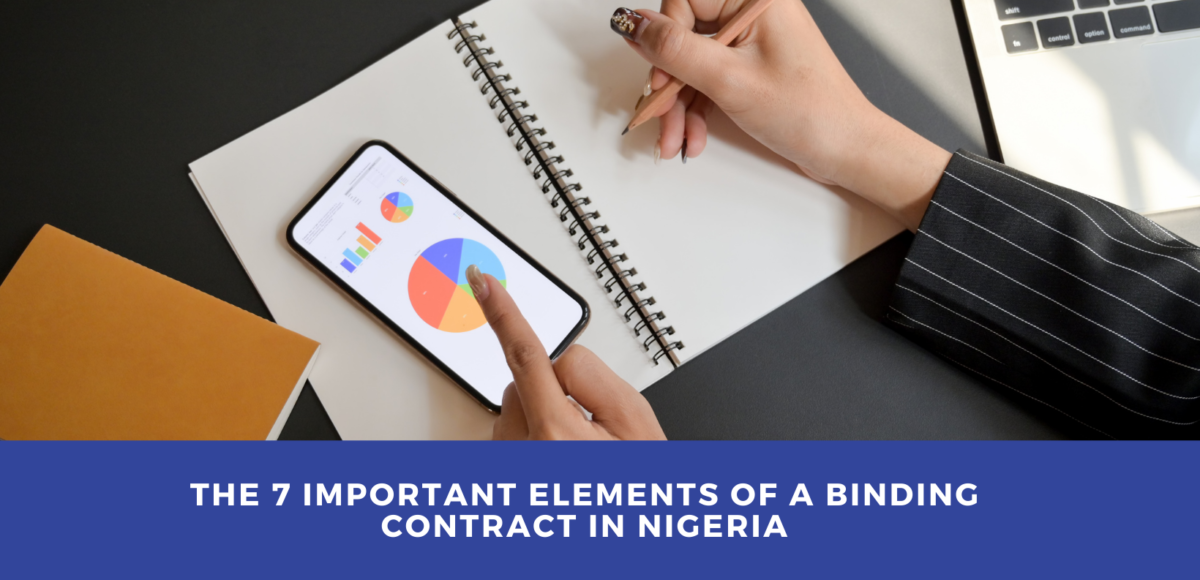
The 7 Important Elements of a Binding Contract in Nigeria
Understanding a binding contract can be a little bit difficult, especially for someone that does not understand the law. Having the knowledge of how a binding contract work gives power to an individual to form a “contracting relationship” with another individual. A “binding contract” is an agreement between two or more persons – generally known as “contracting parties”. This defines and governs the rights and duties of the contracting parties.
Many aspects of our daily lives involve binding contracts that we are not aware of, but at end of this article, you would be able to understand the seven (7) important elements of a binding contract.
1. Applicable law
A binding contract often contains mutually agreed obligations and requirements. These obligations and requirements are laws applicable to any binding contract. For example, the “state laws” that are applicable to a binding contract. We should know that a state has its own laws, so it is important to know the “applicable laws” that are specific to a state before engaging in a binding contract. This is because, a binding contract that is enforceable in a particular state may not be enforceable in another state.
2. Capacity
“Capacity” in a binding contract is the ability of a person to understand the terms and conditions of a binding contract. This ability is usually determined by age and level of understanding. It prevents an individual from taking advantage of another individual’s inability to understand the terms and conditions of a binding contract. Individuals that might not be involved in a binding contract include:
- Minors – generally anyone under 18
- A person who does not understand his/her rights
- A person under the influence of intoxication such as the intake of drugs or alcohol.
A contract can be signed on behalf of a person but only if this individual gives the permission or approval. This is generally referred to as “Power of Attorney”.
3. Offer
An invitation to engage in a binding contract is an ‘Offer’. This is the written promise an individual known as the “offeror” makes to another individual known as the “offeree” in exchange for a “performance”. The one who makes the offer is known as the “offerer,” while the person who receives the offer is called the “offeree.”
Although you can make an offer with just a single-sentence verbal statement, you and the other party will generally benefit from a detailed written description of the offer and its terms. It also explains and clarifies the nature of a binding contract in detail including the rights, obligations, and conditions for the individuals involved in a binding contract.
An offer becomes valid only when the offeree accepts the offer of the offeror. In other cases, the offeree can reject or contest the offer. The offeree is also free to extend a counter-offer. When a counter-offer is made, the original offer is terminated, and the parties are now in the process of bargaining for a new desired outcome.
Note that, with an offer, there is a “power of acceptance” that comes into play. This gives the offeree the power to accept an offer within a specified time and if an offer is rejected, the “power of acceptance” is terminated.
4. Consideration
“Consideration” gives details of the benefits in a binding contract. This allows anyone reading a contract to understand the benefits each person involved in the contract would receive. It answers the question, “what is in it for me?”. Consideration, which must be given in order to make a contract legally binding, is legally sufficient and bargained-for value, given by the promisor in return for the promisee performing or refraining from performing some act which results in a detriment to the promisee and/or a benefit to the promisor.
A bargained for exchange in which there is a legal determinant to the promisor or legal benefit to the promise Consideration cannot be vague or meaningless, otherwise, a contract will be regarded as “no value” or operating on a voluntary agreement in the eyes of the law.
For this reason, an offeror must offer a contract that benefits the offeree for it to be enforceable. However it should be noted that the dispositive issue is the presence of consideration, not the adequacy of the consideration. The values between consideration passed by each party to a contract need not be comparable.
5. Intention
In its simplest form, intention to create legal relations otherwise known as an “intention to be legally bound” means that the parties must intend to enter into a legally binding arrangement in which the rights and obligations of the agreement are enforceable. “Intent” in a binding contract is a person’s awareness of and willingness to comply with the terms and conditions of a binding contract.
A binding contract must be supported with “intention” to create a legal relation. The importance of intention in a binding contract can be considered in the following:
- An Individual engaging in a binding contract must do that with all seriousness.
- In the absence of intention, the individuals involved in a binding contract cannot sue each other.
- A binding contract may become a mere promise if the intention to create legal relations is absent.
Individuals involved in a contract must try to understand the “offer” and “consideration” of a binding contract to avoid misinterpretation and legal issues. This element of a binding contract is often overlooked and without this, a binding contract could be considered illegal. Note that, an agreement based on a handshake or a gentleman’s agreement is not a binding contract. This does not show intent in a binding contract.
6. Certainty
“Certainty” in a binding contract is being free from any doubt, a state of being certain. A binding contract has to be specific. If an individual offers you a service in exchange for a payment, the scope of the service needs to be outlined in detail including the key persons involved in the binding contract.
It is very important that terms are agreed in a contract upfront or, if certain terms are to be agreed at a later date, the parties should give thought as to how supplier and distributor or principal and agent will agree and also what is the default outcome if the parties fail to agree. For example, parties in a distribution agreement may decide that they will agree on a pricing structure for the first contract year but agree on a different structure for subsequent years.
However, this process might not be necessary in some cases, but it is essential for contracts that require certain purchases or specifications, as this would avoid dealing with legal disputes in the long run.
7. Acceptance
This is simply an offeree’s consent to an offer. He/she agrees to be mutually bound to the terms and conditions of a binding contract. Once the offerer takes the payment, an agreement is struck No third person can accept an offer from an offeror without the knowledge of an offeree.
Note that, an acceptance should be relayed in a manner authorized or requested by the offeror. If the offer is rejected, it is regarded as terminated. If changes are made to the terms of the offer, the initial offer will be terminated and replaced with a new offer. The new offer is referred to as a counteroffer.
A binding contract requires a careful understanding of its terms and conditions. Having a binding contract is the best way to manage expectations and clarifies the agreement for all individuals involved. A binding contract gives room for specifications, proper communication, confidentiality, and record-keeping.
Understanding the elements of a binding contract can help you engage in a binding contract without experiencing legal issues. You should know that when there is a breach in a binding contract by a person, the other person may sue for this occurrence. Thank you for reading.

